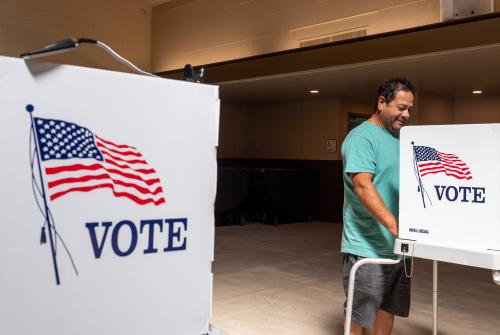The political world received a brief reprieve from coronavirus-related headlines with Sen. Bernie Sanders’s surprise announcement that was suspending his campaign for the Democratic nomination. Though many expected Sen. Sanders to remain in the race despite only an admitted “narrow path” to receiving the nomination, the move leaves former Vice President Joe Biden as the last candidate standing and the presumptive Democratic nominee slated to take on President Trump in the fall.
In looking back at the rise and fall of the Sanders 2020 campaign, we wanted to dig into the claim lobbed by his rivals about his record of legislative achievement (or lack thereof) as a member of Congress. One common refrain from Sanders’s former opponents, especially his female counterparts, was that while he has been very public about his progressive bona fides, he has secured few tangible legislative victories during his time in Congress. In short, he’s been labeled as being all talk and no action.
This wasn’t a new criticism of Sen. Sanders. His 2016 rival, former Secretary of State Hillary Clinton, made perhaps the most scathing comment about his work ethic in the Senate: “Nobody likes him, nobody wants to work with him, he got nothing done. He was a career politician.” In 2020, Sen. Elizabeth Warren made efforts to clearly contrast her concrete policy efforts with Sanders’s talk in a late February Democratic primary debate, saying “I dug in. I did the work… Progressives have got one shot and we need to spend it with a leader who will get something done.” And from Twitter to the debate stage, Sen. Amy Klobuchar often touted her legislative effectiveness in direct contrast to Sanders’s: “A lot of people talk that talk,” she claimed recently in a tacit critique of Sanders. “I have the receipts.”
With these not-so-veiled criticisms, Sanders’s female rivals attempted to position themselves as hard-working lawmakers with a proven history of getting tangible legislative results, and to argue that Bernie Sanders is decidedly not.
What does political science say?
This is not a novel means of differentiation. The political science literature has long suggested that there are two very different types of members of Congress: “work horses,” who steer clear of the limelight in favor of the nitty-gritty, more private aspects of policy production; and “show horses,” who place a premium on attracting publicity rather than advancing legislation within the chamber. Political scientists have often pointed out that gender can play a crucial role in legislative effort, with women adopting high-effort lawmaking styles rather than clamoring for the spotlight.
As an appeal to voters frustrated with politics as usual, Democratic presidential candidates commonly tout their work in Congress as evidence that they’ll be able to reform our politics, institutions, and the way Washington works more generally. Of the current House and Senate lawmakers who decided to take the leap and run in 2020, there was no shortage of candidates who claimed they would be effective reformers in the White House. It was the centerpiece of Elizabeth Warren’s campaign before she dropped out, for example. But of all the candidates this cycle who serve in Congress, who demonstrated the most—and the least—reform activity during their times in office?
The “receipts”: Congressional Reformer Index
For the past year, we have been collecting all types of lawmaker data to identify the members of Congress who are most active in multiple areas of congressional and political reform. The reform categories include: institutional capacity reforms like increasing congressional staff pay, budgetary reforms like biennial budgeting, political reforms like campaign finance and lobbying, and procedural reforms like returning the legislative process to regular order.
Importantly, members of both the House and the Senate were assessed based on not only legislative behaviors like bill introductions, sponsorships, and committee/floor activity, but also in their public advocacy in venues like their floor speeches, congressional newsletters, and official social media content (that is, their accounts directly linked to their current office and not those of the campaign). These data resulted in an overall index of congressional reform activity that combines both legislative and public/advocacy reform activity undertaken by members of Congress.
By collecting both public and legislative behaviors for each of the reform categories we are better able to identify which members are legislative-minded reform “work horses” and which take the more public-facing “show horse” route. The former are the lawmakers who use their elected positions to push for changes to our political positions from the inside; the latter want the public reputation as a doer without taking the painstaking steps to get the job done. To be fair, Sanders has long argued that his revolution of reforms would come not from him, but from his grassroots legion of supporters lobbying from the outside. But Sen. Sanders’s rivals argue that while Bernie has successfully developed a reputation as a leader of this political movement, he hasn’t used his power as a Senator to actually achieve it.
Which presidential candidates are reformers?
First, to identify which presidential candidates have histories of reform advocacy while in office, we made use of the overall Reformer Index which combines both public and legislative behaviors on all categories of reform. With these data in hand, we narrowed it down to the current members of Congress who are either currently running or were previously running for president in 2020, including both House and Senate lawmakers. Using the overall index, we find a very interesting characteristic for those who stand out from the pack: they all lasted the longest in the race.

Beginning with the House, it is notable that Rep. Tulsi Gabbard of Hawaii, an early and controversial entrant into the Democratic presidential primary, leads the pack and scores nearly double the average House member on these reform measures. And while she never gained much traction, Rep. Gabbard accumulated a small but dedicated following in the electorate and was one of the very last candidates to drop out of the race.
The Senate side is even more striking. While presidential dropouts in the Senate such as Kamala Harris (Calif.) and Cory Booker (N.J.) are roughly at or slightly below the average U.S. Senator in terms of their reform-minded activity, the three longest-lasting candidates coming out of the Senate—Amy Klobuchar (Minn.), Elizabeth Warren (Mass.), and still-running Bernie Sanders (Vt.)—are all well above the Senate average and far outpace their also-ran colleagues. Sanders and Warren respectively rank 7th and 10th in the entire Senate on the index.
This finding makes sense given the widespread frustration with Congress and politics more generally that candidates like Barack Obama have successfully voiced in past contests. Voters want to hear about fixes to the broken political system. The presidential candidates who were most successful in the 2020 race were those who were able to reference their histories—both public and legislative—as reform warriors. Plus, the longer a candidate stays in the race, the more they are likely to use their public platform to speak on reform issues. Doing so, of course, increases their reform behavior counts. Overall though, using the combined metric, Sen. Sanders clearly had a credible claim that he is the candidate who has acted most often on issues of political reform.
Walking the walk, or talking the talk?
But, as Sanders’s rivals tried to make clear, talking about reform and trying to get reform legislation passed are two very different things. Are their criticisms correct that Sen. Sanders has mostly talked a big game about his reform-minded policy accomplishments while they’ve actually gotten more done legislatively? Is Sanders merely a “show horse?”
To find out, we broke down the Reformer Index measure based on legislative vs. public-facing reform-minded activities to see if the candidates diverged in a meaningful way. More specifically, we created a percentage of reform-minded activities that were based purely in legislative effort (i.e., bills sponsored) as opposed to public pronouncements (i.e., tweets); the higher the percentage, the more the behaviors were focused on internal work-horse-related reforms.

In both the House and the Senate, those who led their respective chambers among presidential candidates in reform activity are dead last in the percentage of that reform effort dedicated to actual legislative work, as opposed to public-facing media appearances, floor speeches, social media activity in advocacy of those issues. Most notably, Bernie Sanders falls nearly 20 percentage points below the Senate average, and is the only candidate on the list that dedicates more overall congressional reform activity to public pronouncements than to legislative activity. On this metric, Senator Sanders is a clear show horse.
On the other hand, Klobuchar, Warren and Kamala Harris are all clear work horses. But interestingly, so are former candidates Michael Bennet (CO) and Cory Booker (NJ). Kirsten Gillibrand (NY), meanwhile, is by far the most active legislative reformer of the bunch, clocking in at 90% of her effort dedicated to legislative rather than public reform efforts. Eric Swalwell (CA) and Seth Moulton (MA) lead the pack in the House, with the Gabbard falling 10 points below the average House member.
These findings have several potentially big implications, at least for this presidential cycle. First, it’s clear that presidential hopefuls have ideas and behavioral histories on issues of congressional and political reform. Though they vary considerably on how and how often they exhibit reform-minded actions, talking a big game about reform is clearly part of the candidate narrative, and is often an explicit reason why they become candidates in the first place—they want to fix what ails our politics.
Second, having the work horse “receipts” may not be the most effective strategy in communicating a candidate’s reform ideas. Given the trajectories of show horses versus work horses in the 2020 campaign, perhaps the most effective primary strategy is to be known publicly as a reformer even at the expense of actually pursuing the hard and time consuming reform actions within the chambers.
Finally, our results suggest women face a double standard when it comes to being branded as a political reformer. After all, the 2020 race saw four female Senators with above average legislative records on issues important to voters never gain enough traction against fellow Senator Sanders who was far more vocal but far less legislatively active. What’s more, when comparing the average female House member or Senator to their average male counterpart, women lawmakers are much more likely than their male counterparts to pursue legislative fixes on issues of reform. Male lawmakers, on the other hand, are far more public about what they want changed. This gender double standard isn’t at all new, but perhaps is harder to ignore when multiple female candidates struggle to be portrayed as leaders and doers on the topic despite their proven histories of putting in the legislative effort.





Commentary
Bernie talks about a revolution. Does he act on it?
April 9, 2020